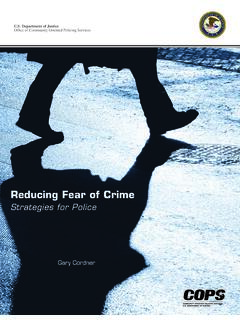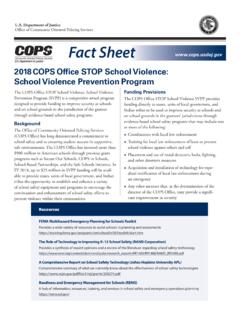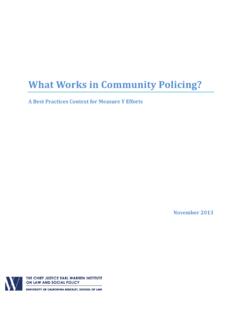Transcription of Police-Community Partnerships to Reduce Domestic Violence
1 Department of Justice Office of community Oriented policing Services COPS community ORIENTED policing SERVICES DEPARTMENT OF JUSTICE By: Melissa Reuland Melissa Schaefer Morabito Camille Preston Jason Cheney Police-Community Partnerships to Address Domestic Violence Police-Community Partnerships to Address Domestic Violence By: Melissa Reuland Melissa Schaefer Morabito Camille Preston Jason Cheney This project, conducted by the Police Executive Research Forum (PERF), was supported by Cooperative Agreement # 98 DV-WX-K018 by the Department of Justice Office of community Oriented policing Services (COPS).
2 Points of view or opinions contained in this document are those of the authors and do not necessarily represent the official position or policies of the Department of Justice or the members of PERF. Cover Design by Ayonna Johnson, Northrop Grumman Contractor to Department of Justice COPS Office Contents Contents I. Introduction .. 1 II. Literature Review .. 3 Changes in Law Enforcement Responses to IPV .. 3 Partnership Response to Domestice Violence .. 4 Report Overview .. 6 III. Mailed Survey .. 9 Methods .. 9 Survey Findings.
3 11 IV. Telephone Interview .. 17 Methods .. 17 Interview Findings .. 17 V. Case Studies .. 21 Methods .. 21 Case Study Findings: Keys to Effective Police Response Case Study Findings: Important and Unique Aspects of Case Study Findings: What Have Been the Barriers to Case Study Findings: What is the Worst Mistake a Police Partnership Descriptions: Eight Core Sites .. 21 Partnership Descriptions: Three Satellite Sites .. 24 To Domestic Violence .. 25 Partnerships .. 29 Case Study Findings: Partnership Resources.
4 33 Case Study Findings: Partnership Goals and Successes ..33 Your Success and How Have you Overcome Them? .. 34 Department Can Make? .. 36 i. Contents VI. Summary .. 41 Survey and Interview Findings .. 41 Summary of Case Study Findings .. 42 Recommendations ..44 Conclusions .. 45 VII. References .. 49 VIII. Additional Resources .. 53 IX. Appendices Appendix A: Mailed Survey Instrument .. 57 Appendix B: Telephone Interview Sites and Interview Protocol .. 60 Appendix C: Site Visit Interview Protocols .. 68 ii. I. Introduction Introduction I.
5 Introduction A number of innovative criminal justice system approaches have been developed during the past 15 to 20 years in an attempt to Reduce the number of incidences of Domestic Violence in the United States. Many law enforcement agencies now have policies mandating arrest, or stating a preference for arrest, for Domestic Violence . Prosecutors are also using a wider array of options to handle Domestic Violence cases such as no-drop policies, evidence-based prosecution, and special district attorneys assigned to Domestic Violence cases.
6 As part of the adoption of community policing across the country, local law enforcement agencies are also forming Partnerships with community organizations to address Domestic Violence . Because there is limited knowledge about how such Partnerships coordinate activities to improve response to calls involving Domestic Violence , PERF was funded by the COPS Office to explore the nature, function, and impact of these Police-Community Partnerships to produce guidance for policy makers on Partnerships focused on Domestic Violence .
7 To learn how the Police-Community Partnerships coordinate their activities and improve their responses to calls involving Domestic Violence , PERF studied a broad sample of local agencies that have such Partnerships . PERF investigators collected data in two phases. In the first phase, project staff reviewed existing literature on the connection between community policing activities and how calls related to Domestic Violence are handled, interviewed experts on Domestic Violence and Police-Community Partnerships , and developed data-collection instruments.
8 In the second phase, project staff used a mail survey and telephone interviews and case studies to collect data on actual Police-Community Partnerships . This report presents a discussion of the literature, describes project methods used and findings of the mail survey, telephone interviews, and case studies of eleven local law enforcement agencies that had formed Police-Community Partnerships to address Domestic Violence . It highlights successful strategies, lists barriers to effective Police-Community Partnerships , and offers recommendations for overcoming these barriers, as well as providing strategies that can be replicated by other agencies.
9 II. Literature Review Literature Review II. Literature Review Data from the last 15 years have shown unprecedented declines in crime. Between 1993 and 2002, the rate of violent crime declined 54 percent (Rennison 2003). During the same period, the National Crime Victim Survey (NCVS) detected similar decreases in nonfatal intimate partner Violence (49 percent for women and 42 percent for men) (Rennison 2003). Homicides by intimate partners have not declined as rapidly: the rate of women who were killed by an intimate partner fell only 22 percent during that period.
10 Continued vigilance on the part of criminal justice and advocacy community is needed to maintain or ideally further these declines. Intimate partner Violence (IPV) is a multidisciplinary concern because victims often are simultaneously involved with the police, the courts, emergency medical services, shelter providers, and counselors. For instance, victims may petition the courts to grant a restraining order, rely on the police to enforce it, and be dependent on social service providers to help them find a safe place to live.











